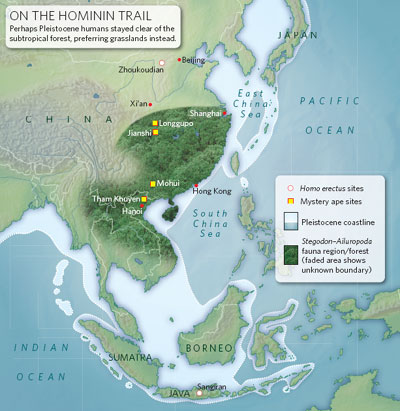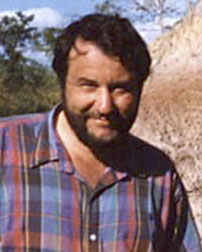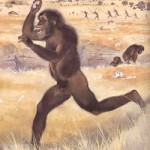New Mystery Ape Fossil ~ Updated
Posted by: Loren Coleman on June 21st, 2009
A fossil discovery of several years ago that was found along with the remains of elephant-like Stegodon, a prehistoric panda Ailuropoda, and the extinct giant ape Gigantopithecus, as well as the ancestors of the living orangutan (Pongo) and gibbon (Hylobates), has been reevaluated as a new “mystery ape.” Actually, the author of the new announcements say there may be “one or more mystery apes indigenous to southeast Asia’s Pleistocene primal forest.”

Click on the map for more details about this fossil ape’s range.
Brian Handwerk reports at National Geographic News on this intriguing idea from Gigantopithecus authority Russell Ciochon, which was announced in the July 18, 2009, issue of the journal Nature.
The link to the Nature item is here. Handwerk’s summary is below.
…the anthropologist announced that the fossil, a partial jaw, is from an ape after all—a “mystery ape.” …
The fossil was found in the 1980s in south-central China’s Longgupo cave. According to Ciochon, “the jaw was very perplexing. It didn’t fit in any category of hominin [early human ancestor] that we knew of in Asia, and it also didn’t fit into any ape category.”
Ciochon and colleagues theorized that the fossil represented an unknown hominid who lived in Asia 1.9 million years ago—about a million years earlier than early humans are generally thought to have arrived in the region.
The ancient hominin, Ciochon’s team suggested in 1995, was a more primitive species than Homo erectus, the human ancestor thought to have migrated from Africa and populated Asia (interactive map of prehistoric human migrations).
The 1995 theory implied that a line of H. erectus could have evolved independently in Asia.
…
As the years passed, Ciochon recounted, new evidence caused him to reconsider the disputed fossil.
First, in 2000 and 2001, scientists showed that the Longgupo jaw had teeth that had strong similarities to those of the older, extinct ape Lufengpithecus, a possible orangutan ancestor.
Then, in 2005, Ciochon examined the large collection of primate teeth from the Pleistocene epoch (about 1.8 million to 11,500 years ago) at the Guangxi Natural History Museum in Nanning, China.
The collection, from a well-documented cave site, included some unidentified primate teeth that strongly resembled those in the Longgupo jaw—and that’s when Ciochon was convinced.
Archaeologist Richard Potts noted that if anyone’s qualified to change the conclusions in this case, it’s Russell Ciochon.
“Russell has probably seen more isolated teeth of primates from this time period than anyone else,” said Potts, director of the Human Origins Program at the Smithsonian Institution in Washington, D.C.
Still, it’s unclear to Ciochon, or anyone else, what such mystery apes were like.
Read more at NatGeo.

Also, worthy of noting is this little side story of Russell Ciochon’s:
In this call to reassess historical assemblages, it is worth remembering the story of ‘Hemanthropus’. Legendary fossil collector Ralph von Koenigswald created this hominin taxon in 1957, based on isolated fossil teeth found in apothecary shops across southeast Asia. Von Koenigswald viewed Hemanthropus as a distant relative of African Australopithecus. Later research revealed that these were worn or atypical orangutan teeth and Hemanthropus was quickly abandoned. But, had von Koenigswald actually discovered evidence of the mystery ape? In October 2005, I examined the original Hemanthropus collection. Among the many worn orangutan teeth I found several small ape teeth that very closely resembled the mystery ape teeth from Mohui. Perhaps von Koenigswald was the first to lay hands on the mystery ape.
About Loren Coleman
Loren Coleman is one of the world’s leading cryptozoologists, some say “the” leading living cryptozoologist. Certainly, he is acknowledged as the current living American researcher and writer who has most popularized cryptozoology in the late 20th and early 21st centuries.
Starting his fieldwork and investigations in 1960, after traveling and trekking extensively in pursuit of cryptozoological mysteries, Coleman began writing to share his experiences in 1969. An honorary member of Ivan T. Sanderson’s Society for the Investigation of the Unexplained in the 1970s, Coleman has been bestowed with similar honorary memberships of the North Idaho College Cryptozoology Club in 1983, and in subsequent years, that of the British Columbia Scientific Cryptozoology Club, CryptoSafari International, and other international organizations. He was also a Life Member and Benefactor of the International Society of Cryptozoology (now-defunct).
Loren Coleman’s daily blog, as a member of the Cryptomundo Team, served as an ongoing avenue of communication for the ever-growing body of cryptozoo news from 2005 through 2013. He returned as an infrequent contributor beginning Halloween week of 2015.
Coleman is the founder in 2003, and current director of the International Cryptozoology Museum in Portland, Maine.











It’s these kind of things that make me shake my head when…scoftics:) step up and say there is no BF or no possibility of BF because there is no evidence in the fossil record.
There are always new things showing up and being found in the fossil record, and so obviously, we do not have a complete historical record of the world of animals from the fossil record. AND that is what is so cool about new finds, because every time something new pops up, we get info that shapes, modifies and even changes what we know about the previous ages.
So, cool!
Very true springheeledjack…I couldn’t agree more! I love checking out this website every single day, not just for the totally awesome stuff Loren posts, but for the way some others post comments about just what I’m thinking as I read it!
SHJ: bravo.
One thing that will clue me in that you are an ignoramus (and I hear scientists say this all the time) is using that old fossil-record chestnut.
So we’ll just keep on and keep on finding fossils of everything out there. Everything but primates in North America (which we do have). We’ll never find, those, ever. Must be nice to have that scientifical second sight.
And of course this says nothing about the ”primate stratum” being particularly susceptible to stuff like construction, pipe laying and well digging. ”Hey look at this!” ”That’s a cow; I never want to hear about it again. You stop this building from going in, you’re out of a job.” Never happened, couldn’t happen, scientifically and logically and click-heels-threetimeishly IMPOSSIBLE. Or more likely they thought the bones were really a cow, or a bear, which a scoftic will tell you is impossible to do, in the next breath telling you that people mistake cows and bears for sasquatch all the time.
You wonder what they smoke when they leave the office.
I wanna picture of the skull.What about you guys?
Very, very interesting story and data there, Loren.
The Lord knows what new “theories” about our “origins” will be seeing the light of day a decade or so from now. I can’t wait, personally.
And CryptoHuntr:
I also want a picture of the skull.
Is it coincidence alone or is there some speculation out in the broader paleoanthropological world regarding the mysterious and contradictory evidence on the ancestral red apes of asia and its seemingly DNA defying relationship to our own?
Seeing a skull would be nice, particularly if it provides for a comparison of the dental features. Once upon a time those were considered important regarding evolutionary relationships. Who knows, maybe they will once again and the orthodox logic of DNA will be reformed to accomodate new understanding. Cheers.
A partial jaw?! That’s all they have and they are saying what?!
Well, bigfootsdad, scientists do have a strong tendency to make grand pronouncements on very little evidence.
Not that there’s anything wrong with that. 😀
You can’t change the scientific model unless there’s a model to change, I guess. So they’re postulating a model for this find based on evidence in hand. I’m OK with it, just so long as the model changes when it has to. Providing a touchstone for future research is what this is about. I mean, if you needed absolute knowledge before making a pronouncement, we’d still be waiting for the first pronouncements from the fossil record.
Oh.
Happy belated Father’s Day. 😉
Bigfootsdad, I wouldn’t disparage the findings based on there being what to you seems like an insignificant fragment. People sometime as “how could they determine all that from just one tooth or even a piece of tooth, or jawbone?” and when someone who knows tries to explain, the layman’s eye’s just glaze over and accuse the scientist of just spouting what seems to the uninformed to be just jargon, jibberish and wild speculation, but if you were to go read a few books on paleoanthropology dating from before the introduction of molecular biology and DNA studies, you would see that there are some very special features that can be determined from the dentition and jaws of animals, primates especially and address the human relatedness in particular. Teeth and jaws are viewed as not being subject to the same kinds of selective pressures that some other more superficial and recognizable morphological features do, like hair patterns, or size…which to the layman is most often the traits that give species their “essentialness”, though they may be of little importance to some populations…take dogs for example. Who’d a thunk that based on looks they’re all one species, but see a dogs jaw or tooth and a canine anatomist can tell some remarkable things others would not notice or even imagine. Bear in mind also that some of the statements are intended to be addressing hypotheticals and not meant as statements of fact or of hard evidence though for editorial succinctness the articles in the popular press don’t delve into that aspect and, never the less, they are not just wild speculation by mere enthusiasts but are backed by meticulous study, measurement and quantitative analysis.
Cheers.
dogu4: as you note, scientists can draw much from what seems insignificant.
What they draw isn’t incontrovertible fact; it’s an inference, based on models built from intelligent speculation on previous finds. A “missing link” could be an evolutionary dead end; it’s just that, if some traits of a more primitive and some of a more advanced form occur in the same find, that’s not the way the evidence and the models built upon that evidence tell a scientist to bet.
The partial jaw here is recognized as an anomaly because it simply doesn’t fit with others found. The teeth seem to argue against the orginal thesis for that jaw based on similarities discovered after that thesis was propounded.
Shoot, it is anybody’s guess what that jaw came from. But for scientists, an educated guess is better than any old guess. And I’d have to go with the bet placed here. Realizing that a bet is all it can ever be.
That’s an enlightened perspecitve, DWA. Thanks for that. I agree fully and look forward to more and deeper understanding that comes from a number of areas: more fossils(and a renewed interest in the quantitative and qualitiative analysis, a better read on junk dna and chromosomes in the modern sense (the recent suggestion that the simple varying of chromosomal numbers are not as critical to speciation as might have been thought…this regarding specifically North American and Eurasian Moose populations), and paleobiogeography which never fails to fascinate me personally. Cheers.
dogu4: thanks.
In another thread (and on many on this site) I mention the folks that strike me as having the most enlightened skeptical attitudes. I really should mention you more often. You’re one of the “purest” (hate that word but I hope folks will understand) cryptos here, with an attitude grounded in the real but questing beyond what’s known.
Not only should crypto be like that; no science worth its salt can afford NOT to be. Particularly here; Ciochon’s at the boundary of hard science and crypto here, and he probably knows that.
And of course, as I noted, my post just stood on your post’s shoulders. 😉
I think Ciochon is doing no more and no less than what science should do here – pointing out how our picture seems to have changed a bit, and where we might focus further to be sure. (As sure, noted, as we can ever get.)
Thanks for the kindwords, DWA. My compliments to you, and the others here who find a deep examination of natural history at least as interesting and fascinating as any more fancifull explanations, though even those sometimes bring out aspects that our own internalized orthodoxy dictates and needs to have questioned. Cheers.
Okay. It’s a partial jaw. Loren,WOULD YOU GET A PICTURE!!!!! I wanna picture. Before i admit its from bigfoot,i wanna PICTURE